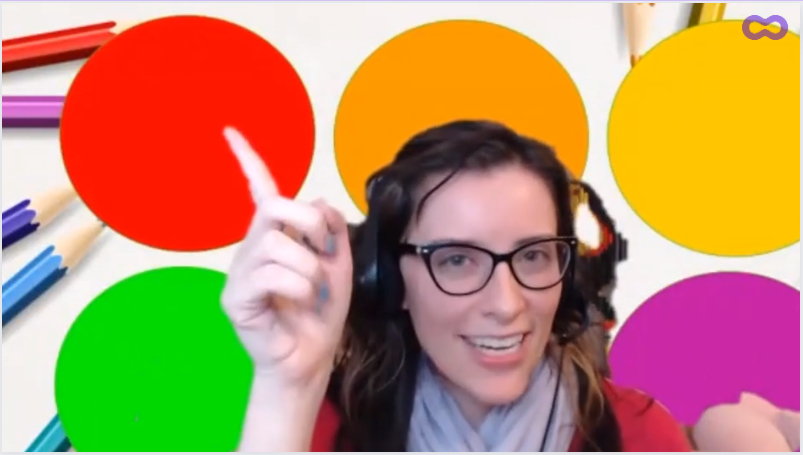Ivana Winslow teaches about 30 learners a week enrolled in private Spanish lessons, mostly using the ongoing class format.

That’s a big leap from her early days on Outschool when she was happy to have even five learners signed up.
She has worked hard over the past three years to get her business up and running and has developed systems that make it easy to teach so many 1-on-1 learners.
How has she done it? Her success has come from:
- Putting in the time to plan a curriculum and gather tools
- Honing her teaching style
- Following up with learners and tracking their progress
We’ll dive into each of those elements next!
Lean into a teaching niche that’s your sweet spot
For Ivana, teaching private lessons has been a good fit in multiple ways. “I’ve always liked one-on-one instruction and beginner Spanish is my specialty,” Ivana says. “So I’ve been doing that exclusively for about a year.”
She especially likes that once one learner signs up, the class is a go. There’s no waiting to see how many learners sign up or teaching one learner at a group rate. Plus, she is able to tailor each lesson to meet each individual needs.
Plan your curriculum and tools
It took Ivana some time to develop a full complement of lesson plans and to have props and tools handy to enrich her classes. She created PowerPoint slides and worksheets and now has the materials ready to teach a lot of students.
“I don’t have to plan as much now since I have everything,” she says.

Because her classes focus on beginner Spanish, she usually starts with numbers and colors and basic greetings. “I usually build from there, and if they already know something like days of the week I’ll skip material,” she says. “But otherwise I generally move along the curriculum.”
Keep momentum going between classes
After each class, Ivana will leave a message for each learner on the classroom page, perhaps mentioning something that they did well in class. She’ll also add a follow-up activity the learner can do at home like test themselves with a Quizlet flash card set or watch a relevant YouTube video.
If learners engage in related activities outside of class, she says, they are likely to retain the information better.
Differentiate lessons based on learner needs
Ivana’s classes are most popular with learners in the 7- to 11-year-old range, and students usually attend either for enrichment or help with an in-person school Spanish class. The majority of students are new to Spanish and just want to practice speaking, but Ivana has more advanced Spanish lessons ready if needed.
When a learner enrolls, she will check their age and ask if they have any experience with Spanish. “I’ll get every now and then a 6-year-old who speaks Spanish at home,” she says, “so their speaking fluency is pretty decent. But I always have certain topics that I know are tricky for all language learners like grammar.”
For learners looking for help with another Spanish class, Ivana reaches out to ask what they’re working on in class and need help with. “We work on whatever materials the teacher is using because it’s usually very specific to the teacher when they’re in school,” she says.
If an older student signs up, Ivana brings in advanced concepts, even if the learner is new to Spanish. Ivana recalled working with one high school student: “We started to move into verbs and grammar because I know at that age they can pick up on grammar rules a lot better.”
Usually in the first few minutes of class, Ivana informally assesses a learner’s Spanish skills.
“The very first thing I do with every class is ask them what numbers they know,” she says. “Just the speed in which they say it, the pronunciation, how many numbers, that alone tells me a lot, even their confidence.”
Keep classes positive for learners
What’s important, Ivana says, is to make sure each learner has a positive experience in her class.
To that end, she provides scaffolding where needed—just the right support that makes learning not too hard or too easy. For instance, if a learner isn’t sure of an answer, she’ll give them a choice of two possible responses. Generally, she says, they can identify the correct answer.
Ivana says she makes sure she’s very friendly and has a positive, supportive tone in class. If someone gets an answer wrong, she’ll correct it indirectly so this doesn’t feel like a correction. She also gives a lot of positive reinforcement for what learners are doing well.
With an older learner, Ivana may be more explicit and normalize mistakes as part of learning: “Learning a language is hard, and making mistakes is all right.”
Ivana also has props like a stuffed toy that younger learners can talk to if they seem nervous speaking Spanish to her. “I can tell sometimes they’re feeling a little stressed about me,” she says, “so I’ll have them ask the toy a question.”

Make the class engaging
Ivana has lots of tech tools and props that she uses to hold learners’ interest. She uses digital backgrounds, for instance, where she can point to colors or other vocabulary words that students are learning.
She also uses both Google Jamboard, where learners can draw on the screen, and a physical whiteboard. “So I’d say having a mix of real items and digital, but not all digital, seems to be a good balance for me,” Ivana says.
The day before a class, Ivana usually will post a worksheet in the virtual classroom. However, she’s always ready with a digital version in class if the learner didn’t print it out and do it.
“I use remote sharing a lot on Zoom where you can give them access to moving your pencil around,” she says. “So that way I can have them write on the worksheet digitally.” In some cases, this can be too difficult for learners, so then Ivana will listen to their answers and do the writing on the sheet herself.

She continues to find ways to personalize communications with families. “I know they’re paying for my service and they picked me out of all the other teachers,” Ivana says, “so I want to make it feel like it’s worth the investment.”
Maximize organization to save time
Ivana has a few techniques to track learner progress and easily pick up where they last left off in lessons. She’ll check notes in multiple places:
- A notebook where she writes each learner’s first name and the topics they’ve covered
- The classroom page where she put follow-up activities
- Digital notes from class activities on Jamboard
- Private learner notes in the classroom
Another critical tool she uses is a Google Sheets document where she puts links to her core slides and other materials. This saves Ivana time and frees her to focus on other aspects of teaching instead of searching her Google Drive for needed documents.
Also on this spreadsheet she puts each learner’s first name and links to their records and worksheets. “This has made it so much easier to have more students,” she says, “because I have every student’s digital worksheet in one place.”
Optimize your presence on Outschool
Ivana schedules as many classes as she can, even if they likely won’t all fill up. That way, if families are searching on Outschool for private Spanish classes, one of her classes may come up. She also recommends that strategy for educators new to Outschool.
In the end, she advises to just jump into teaching online and expect that growing a following will take some time.
“It definitely took at least a few months to actually start getting a good amount of bookings,” she says, “and then getting some ratings helped with the overall booking.”
Check out the video below to see the full interview with Ivana on Spanish tutoring.

